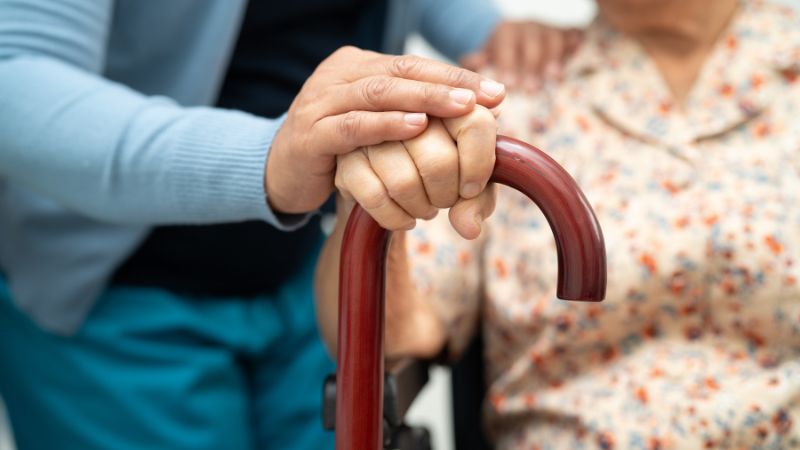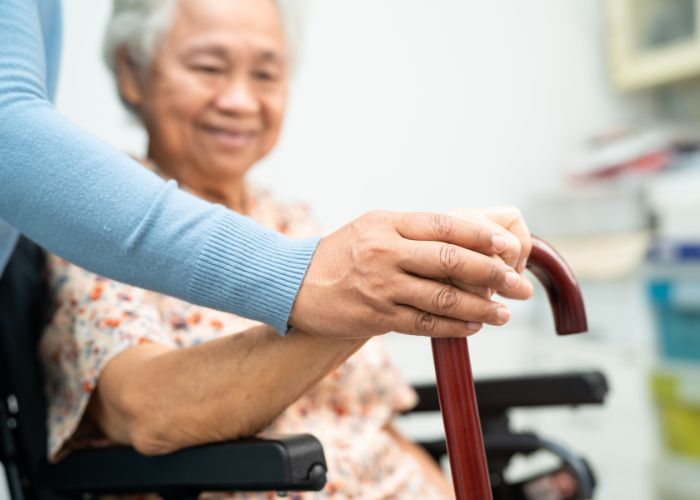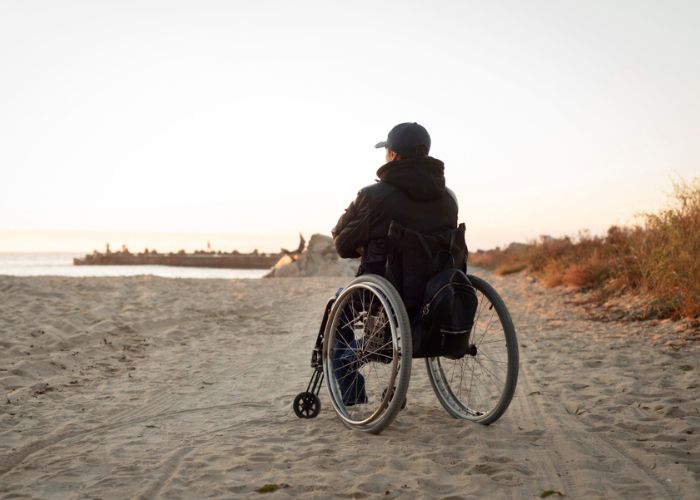Understanding CDPAP
Navigating Your Way Through CDPAP: A Beginner's Guide

Navigating the healthcare landscape can often feel like trying to find your way through a labyrinth. For those considering the Consumer Directed Personal Assistance Program (CDPAP), this feeling can be all too familiar. However, CDPAP offers a unique opportunity for individuals in need of personal care to take charge of their care management in a way that traditional home care options do not allow. This guide aims to illuminate the path for beginners, providing a comprehensive overview of CDPAP, from understanding its core principles to successfully applying and managing your care.
What is CDPAP?
At its heart, CDPAP is an innovative Medicaid program available in certain areas that allows individuals requiring home care services the ability to choose and direct their own caregivers rather than going through traditional home care agencies. This model not only empowers patients and families but also introduces flexibility and personalization into the care process, accommodating the unique needs of each individual.
Who is Eligible?
Eligibility for CDPAP hinges on several criteria, primarily that the individual must be a recipient of Medicaid and require help with daily living activities or skilled nursing services. Additionally, participants must be capable of making informed decisions about their care or have a designated representative who can make these decisions on their behalf.
Managing Your Caregiver
One of the unique aspects of CDPAP is the level of control and responsibility it places on participants. Managing your caregiver involves setting schedules, defining tasks, and ensuring that care standards are met. It’s also important to manage the administrative aspects, such as submitting timesheets and handling any disputes that arise.
The Benefits of CDPAP
The flexibility to choose and direct your caregiver ensures that care is more personalized and adaptable to your lifestyle. Moreover, by allowing participants to hire family members, CDPAP fosters care that is not only competent but also compassionate and familiar.
Challenges to Consider
While CDPAP offers numerous benefits, it also comes with its challenges. The administrative responsibility can be significant, and navigating Medicaid and program requirements can be complex. Additionally, the success of your care under CDPAP largely depends on the reliability and capability of your chosen caregiver.
CDPAP represents a significant shift towards patient-centered care, offering more control, flexibility, and the possibility for care by familiar faces. While the path to navigating CDPAP may seem complex, understanding the program’s framework, eligibility criteria, and the responsibilities it entails can demystify the process. For those willing to undertake the journey, CDPAP can provide a rewarding approach to home care, rooted in dignity, autonomy, and personalized attention.
The Benefits of Choosing Consumer-Directed Care

In the evolving landscape of healthcare, the push towards more personalized and patient-centric models has led to the rise of consumer-directed care (CDC). This model empowers individuals to make decisions about the type of care they receive and who provides it, marking a significant shift from traditional care methodologies. Below, we explore the myriad benefits of choosing consumer-directed care, illustrating why it has become an attractive option for many seeking health and personal care services.
Personalization
At the heart of consumer-directed care is the ability to tailor healthcare services to fit individual needs, preferences, and lifestyles. Unlike traditional care models that offer a one-size-fits-all approach, CDC allows patients to have a say in every aspect of their care, from the selection of caregivers to the scheduling of services. This level of personalization ensures that care is more aligned with the patient’s requirements and goals, leading to better outcomes and satisfaction.
Empowerment and Independence
Consumer-directed care inherently promotes independence and self-determination. By giving individuals the control to manage their care, it empowers them to make decisions that best suit their circumstances. This empowerment can lead to increased motivation, self-efficacy, and a sense of control over one’s life, which are critical factors in the overall well-being and quality of life, especially for those with chronic conditions or disabilities.
Enhanced Quality of Care
When consumers direct their care, they can choose caregivers who they trust and who understand their unique needs and preferences. This often leads to a higher quality of care, as the caregivers are more invested, and the care is more consistent and attentive. Moreover, the direct relationship between the consumer and the caregiver can lead to better communication, enabling the caregiver to respond more swiftly and appropriately to the consumer’s changing needs.
Cost-Effectiveness
Consumer-directed care can also be more cost-effective than traditional care models. By managing their care, individuals can optimize how their healthcare dollars are spent, focusing resources on services that offer the most benefit to their specific situation. Additionally, by avoiding the overhead costs associated with traditional care agencies, more of the available funds can be directed towards the actual provision of care.
Flexibility and Convenience
The flexibility of consumer-directed care is unparalleled. Consumers can adjust care schedules and services as their needs change, without having to navigate the bureaucracy that often accompanies traditional healthcare services. This flexibility is especially beneficial for those with fluctuating conditions or those who require care outside of normal business hours, providing a level of convenience that traditional models cannot match.
Building Meaningful Relationships
Choosing who provides care often leads to stronger, more meaningful relationships between consumers and their caregivers. This personal connection can significantly enhance the care experience, as caregivers become more attuned to the needs and nuances of those they are supporting. Such relationships foster a sense of companionship and reduce feelings of isolation, which is particularly important for the elderly and those with long-term health conditions.
Challenges and Considerations
While consumer-directed care offers numerous benefits, it also presents challenges, such as the need for consumers to take on more responsibility for managing their care. This can include tasks such as hiring and supervising caregivers, managing budgets, and navigating legal requirements. Therefore, consumer-directed care may not be the best fit for everyone, and individuals should consider their ability to manage these responsibilities when choosing this model.
Consumer-directed care represents a shift towards more individualized, empowering, and flexible healthcare options. By allowing individuals to personalize their care, it enhances the quality of services, fosters independence, and can lead to more cost-effective outcomes. While it requires a greater level of engagement and management from consumers, the benefits of such a model are clear, making it an increasingly popular choice for those seeking to take control of their healthcare journey.
Advanced CDPAP Planning: Ensuring Continuity of Care

In the evolving landscape of home health care, the Consumer Directed Personal Assistance Program (CDPAP) stands out as a beacon of innovation, offering patients the unique opportunity to manage their own care. This self-directed approach not only empowers individuals with chronic illnesses, disabilities, or aging-related needs but also ensures that the care received is tailored to their specific preferences and requirements. However, navigating the complexities of CDPAP requires thoughtful planning and strategy, especially when it comes to ensuring continuity of care. In this article, we delve into the essence of advanced CDPAP planning and share insights on how patients, families, and caregivers can work together to maintain a seamless care experience.
Understanding the Importance of Continuity in CDPAP
Continuity of care is crucial in any healthcare setting but becomes particularly vital in a program like CDPAP, where patients have the autonomy to select their caregivers. This personalized model fosters a deeper caregiver-patient relationship, enhancing the quality of care. Yet, it also introduces challenges in maintaining consistent care, especially during transitions such as caregiver changes, health status fluctuations, or administrative adjustments.
Strategies for Advanced CDPAP Planning:
Comprehensive Caregiver Selection and Training
Choosing the right caregiver is the cornerstone of effective CDPAP planning. Beyond selecting someone based on trust and personal connection, consider their ability to meet the patient’s evolving needs. It’s also essential to provide comprehensive training for caregivers, covering not just the basic care tasks but also emergency procedures, health condition-specific care techniques, and soft skills like communication and empathy.
Developing a Detailed Care Plan
A well-crafted care plan is your roadmap to continuity. This plan should outline the patient’s daily routines, medical needs, emergency protocols, and any other pertinent information that ensures the caregiver is prepared to provide consistent care. Regularly reviewing and updating the care plan in collaboration with healthcare professionals ensures that the care remains aligned with the patient’s current needs.
Building a Support Network
Creating a network of support that includes family members, friends, healthcare providers, and even additional caregivers ensures that there’s always someone available to step in when needed. This network can provide respite for the primary caregiver and assist in various aspects of care, ensuring the patient’s needs are continually met without interruption.
Leveraging Technology
Technology can play a pivotal role in ensuring continuity of care in CDPAP. From digital care logs and medication reminders to telehealth services and communication platforms, technology can help streamline care management, facilitate communication among the care team, and ensure critical information is readily accessible.
Planning for the Unexpected
Advance planning for potential disruptions in care is crucial. This includes having backup caregivers, understanding the administrative processes of CDPAP, especially regarding caregiver changes, and ensuring financial and legal affairs are in order to support care transitions smoothly.
The Role of Fiscal Intermediaries
Fiscal intermediaries in CDPAP play a vital role in supporting continuity of care. They not only handle the administrative and financial aspects of the program but can also offer resources for caregiver training, support in emergency situations, and guidance on program regulations. Engaging actively with your fiscal intermediary can provide an additional layer of stability and support for both patients and caregivers.
Advanced planning in CDPAP is not just about preparing for the future; it’s about creating a foundation of care that adapts to the patient’s evolving needs while maintaining the essence of personal choice and autonomy. By implementing strategic planning, leveraging support networks, and utilizing technology, patients and families can ensure that the care journey through CDPAP is not only personalized but also continuous, stable, and responsive to their changing needs. As we navigate the complexities of personal health care management, the focus on continuity within CDPAP offers a valuable blueprint for delivering compassionate, individualized care that truly makes a difference in the lives of those it serves.
Exploring the Psychological Benefits of CDPAP for Families

The Consumer Directed Personal Assistance Program (CDPAP) is a revolutionary Medicaid program that allows individuals requiring home care to select, hire, and direct their caregivers. While the tangible benefits of this program, such as personalized care and flexibility, are well-documented, it’s essential to delve into the psychological benefits that CDPAP offers to both patients and their families. This article explores the profound impact CDPAP can have on the mental and emotional well-being of those involved.
Empowerment and Independence
One of the most significant psychological benefits of CDPAP is the sense of empowerment it gives to patients. By taking charge of their care, individuals feel more in control of their lives, which is crucial for mental health. This autonomy not only boosts their self-esteem but also contributes to a more positive outlook on life. For family members, seeing their loved ones assert independence can alleviate feelings of worry and helplessness, ensuring a healthier psychological environment for everyone involved.
Strengthening Family Bonds
CDPAP fosters stronger family relationships by allowing family members to become paid caregivers. This arrangement can transform the caregiving role from a potential source of stress to an opportunity for bonding. Sharing the responsibility of care within the family can create a deeper understanding and appreciation for each other’s roles, enhancing emotional connections and reducing the risk of relational strain.
Reducing Anxiety and Stress
Navigating the healthcare system can be a daunting task for families, often leading to increased anxiety and stress. CDPAP simplifies this process by giving families the autonomy to manage care according to their specific needs and preferences. This direct involvement can significantly reduce worries associated with traditional home care services, such as caregiver compatibility and quality of care, thereby offering peace of mind to families.
Enhancing Quality of Life
The flexibility of CDPAP means that care can be tailored to the individual’s lifestyle and preferences, contributing to a better quality of life for the patient. For families, this means that their loved ones can maintain their routines and continue participating in preferred activities, which is vital for mental health. Knowing that care is personalized and delivered by someone they trust can significantly improve the psychological well-being of both patients and their families.
Promoting Social Interaction
CDPAP also offers psychological benefits by promoting social interaction. Patients have the opportunity to choose caregivers with whom they share interests or have a strong emotional connection, such as family members or close friends. This social aspect of care is crucial for mental health, as it can prevent feelings of isolation and loneliness, which are common issues among individuals receiving home care.
The Consumer Directed Personal Assistance Program goes beyond providing practical home care solutions by offering significant psychological benefits to patients and their families. By fostering empowerment, strengthening family bonds, reducing anxiety, enhancing quality of life, and promoting social interaction, CDPAP plays a crucial role in improving the overall mental and emotional well-being of those it serves. As more families become aware of these benefits, CDPAP is set to redefine the landscape of home care, making it a more inclusive, flexible, and psychologically beneficial service for all involved.
Embracing CDPAP can lead to a transformative experience for families, turning the challenges of caregiving into opportunities for growth and deeper connections. The psychological benefits of CDPAP underscore the importance of considering mental and emotional health in-home care, paving the way for a more holistic approach to patient and caregiver well-being.
Navigating Legislative Changes in the CDPAP

The Consumer Directed Personal Assistance Program (CDPAP) has been a beacon of hope and independence for many individuals requiring home care and their families. It offers a unique approach, allowing consumers or their designated representatives to take charge of their care by hiring, training, and directing their caregivers. However, as with any healthcare program, CDPAP is subject to the ebb and flow of healthcare legislation, which can significantly impact how the program operates and its benefits. This article explores how to navigate the changing landscape of healthcare legislation affecting CDPAP and what it means for consumers and caregivers alike.
Understanding the Legislative Landscape
Healthcare legislation is constantly evolving, influenced by political, economic, and social factors. Changes can stem from federal, state, or local laws and can affect various aspects of CDPAP, including eligibility criteria, funding, and the roles and responsibilities of participants. Staying informed about these changes is crucial for both current and prospective CDPAP participants to ensure they can maximize the benefits of the program.
The Importance of Advocacy
Advocacy plays a pivotal role in shaping healthcare legislation. Consumers, caregivers, and advocacy groups can influence policymakers by sharing their experiences and the positive impact CDPAP has on their lives. Engaging in advocacy efforts, such as participating in public hearings, contacting legislators, or joining consumer advocacy groups, can help safeguard the interests of CDPAP participants and ensure the program continues to meet their needs.
Adapting to Changes
When changes in legislation affect CDPAP, participants need to adapt to maintain the continuity and quality of care. This may involve re-evaluating care needs, adjusting care plans, or even renegotiating caregiver agreements. Flexibility and open communication between consumers and caregivers are vital to navigating these changes effectively.
Seeking Information and Support
With the complexity of healthcare legislation, seeking information and support is key to understanding and adapting to changes affecting CDPAP. State and local health departments, CDPAP fiscal intermediaries, and advocacy organizations can provide valuable resources and guidance. These entities can help interpret legislative changes, explain their implications, and offer advice on how to comply with new requirements.
Leveraging Technology
Technology can be a powerful tool in navigating changes in healthcare legislation. Online forums, social media groups, and newsletters from advocacy organizations can offer timely updates and insights. Additionally, leveraging management software specifically designed for CDPAP can help streamline administrative tasks and ensure compliance with new legal requirements.
Navigating changes in healthcare legislation is an ongoing challenge for CDPAP participants. However, by staying informed, engaging in advocacy, adapting to changes, seeking support, and leveraging technology, consumers and caregivers can continue to benefit from the autonomy and personalized care that CDPAP provides. As healthcare legislation evolves, the resilience and proactive engagement of the CDPAP community will be key to ensuring that the program remains a vital and effective option for those in need of home care.
How CDPAP Enhances Patient Autonomy and Satisfaction

The Consumer Directed Personal Assistance Program (CDPAP) represents a paradigm shift in-home care, emphasizing patient autonomy and personalized care. Unlike traditional home care models, where agencies dictate the terms of care, CDPAP places the control directly in the hands of patients and their families. This innovative approach has significantly enhanced patient autonomy and satisfaction, reshaping the landscape of home care services. This article explores the mechanisms through which CDPAP achieves these outcomes and the profound impact on participants.
Empowering Patient Choice
A cornerstone of CDPAP is the empowerment of patients to make their own choices regarding their care. This includes selecting who will provide their care, whether it be a family member, friend, or someone else they trust. By allowing patients to choose their caregivers, CDPAP ensures that care is provided by individuals who understand the patient’s unique needs, preferences, and cultural nuances. This level of personalization and comfort cannot be overstated, as it significantly contributes to a patient’s overall satisfaction and well-being.
Flexibility in Care
CDPAP offers unparalleled flexibility in how care is delivered. Patients can set their schedules and determine the tasks their caregivers perform, aligning care with their lifestyle and personal needs. This flexibility ensures that patients do not have to adjust their lives to accommodate care schedules, a common issue with traditional home care services. Instead, care integrates seamlessly into the patient’s life, enhancing their autonomy and satisfaction with the services received.
Enhancing Quality of Life
By prioritizing patient autonomy, CDPAP directly contributes to an enhanced quality of life. Patients feel more in control of their care and, by extension, their lives. This empowerment can lead to better mental and emotional health, as patients are less likely to feel like passive recipients of care and more like active participants in their care journey. The ability to maintain a sense of normalcy and continue engaging in preferred activities with the support of a chosen caregiver can significantly improve a patient’s outlook and satisfaction.
Strengthening Relationships
The CDPAP model fosters stronger relationships between patients and caregivers. When caregivers are family members or friends, the care process becomes an extension of their existing relationship, deepening bonds and providing care in a context of mutual respect and understanding. Even when caregivers are not pre-existing acquaintances, the very act of choosing and directing their care creates a foundation for a strong, collaborative relationship based on trust and personalized care.
Reducing Hospital Readmissions
A less direct but equally important aspect of patient autonomy under CDPAP is its potential to reduce hospital readmissions. When patients receive care that is closely aligned with their needs and preferences, they are more likely to follow through with prescribed care plans and engage in preventive measures. This personalized approach can lead to better health outcomes and fewer hospitalizations, further enhancing patient satisfaction with the program.
CDPAP has revolutionized home care by putting patients at the center of the care process, offering them control over who provides their care, when it is provided, and what it entails. This focus on patient autonomy and personalized care has led to increased satisfaction among participants, as it respects their individuality, enhances their quality of life, and strengthens the caregiver-patient relationship. As healthcare continues to evolve towards more patient-centered models, CDPAP stands as a testament to the positive outcomes that can be achieved when patients are empowered to direct their care.
The Role of CDPAP in Facilitating Community Integration

The Consumer Directed Personal Assistance Program (CDPAP) has been pivotal in transforming the landscape of home care by promoting patient autonomy and personalized care. Beyond its immediate benefits to individuals and their families, CDPAP plays a significant role in facilitating community integration for people with disabilities or those requiring long-term care. This aspect of CDPAP not only enhances the quality of life for participants but also fosters a more inclusive community. Let’s delve into how CDPAP contributes to this vital goal.
Empowering Participants with Choice and Control
CDPAP empowers individuals by giving them the choice and control over their care, including who provides it and how it is provided. This empowerment extends beyond the confines of their homes, encouraging participants to engage more actively with their communities. When individuals have control over their care arrangements, they are more likely to participate in community activities, attend social gatherings, and maintain employment or education, thereby integrating more fully into society.
Promoting Independence and Mobility
One of the key benefits of CDPAP is its emphasis on promoting independence among its participants. By allowing individuals to choose caregivers who can support their specific needs, CDPAP enables participants to navigate their communities more freely and confidently. This could involve assistance with transportation, attending community events, or simply engaging in everyday activities outside the home. The program’s flexibility ensures that care schedules can be adjusted to accommodate community involvement, further enhancing participants’ ability to integrate into their local environments.
Strengthening Social Networks
CDPAP fosters stronger social networks by encouraging interactions between participants and their chosen caregivers, who are often family members, friends, or neighbors. This not only deepens existing relationships but can also help forge new ones within the community. Additionally, caregivers, who are integral to the participants’ community engagement, often become advocates for accessibility and inclusion, further strengthening community bonds and awareness.
Enhancing Community Awareness and Inclusion
The visibility of CDPAP participants in the community serves to increase awareness about the diverse needs of people with disabilities and the elderly. This visibility is crucial for fostering a culture of inclusion and understanding. It prompts local businesses, organizations, and public services to consider accessibility and accommodations, making communities more welcoming for everyone. CDPAP’s role in this process is indirect but profoundly impactful, as it enables participants to be active, visible members of their communities.
Supporting Employment and Educational Opportunities
For many CDPAP participants, the program’s support extends to pursuing employment and educational opportunities. By receiving care that accommodates their work or school schedules, individuals can continue to develop professionally and personally, contributing to their communities in meaningful ways. This not only benefits the participants but also enriches the community with diverse perspectives and talents.
The role of CDPAP in facilitating community integration is a testament to the program’s holistic impact on participants’ lives. By empowering individuals with choice and control over their care, promoting independence, strengthening social networks, enhancing community awareness and inclusion, and supporting employment and educational opportunities, CDPAP is helping to build more inclusive and supportive communities. As we continue to advocate for programs that respect individual autonomy and encourage active participation in society, CDPAP stands as a leading model of how healthcare services can contribute to a more integrated and inclusive world.
Effective Communication Strategies for CDPAP Teams

Effective communication is the cornerstone of successful care in the Consumer Directed Personal Assistance Program (CDPAP). This program empowers individuals needing home care to hire, manage, and direct their caregivers, including family members, friends, or acquaintances. While CDPAP offers unparalleled flexibility and personalization, its success heavily relies on clear, consistent communication between all parties involved. Here are some strategies to foster effective communication within CDPAP teams, ensuring a harmonious and efficient caregiving environment.
Establish Clear Roles and Expectations
At the outset, the consumer (the individual receiving care) and their assistant(s) must have a clear understanding of each other’s roles and expectations. This includes specific care tasks, schedules, and any other preferences or requirements. Creating a written agreement or care plan can serve as a useful reference for both parties, reducing misunderstandings and setting a clear framework for the care provided.
Regular Check-ins and Feedback
Regularly scheduled check-ins can greatly enhance communication. These can be daily, weekly, or at intervals agreed upon by both parties. Use these check-ins to discuss the care provided, any changes in health or care needs, and to provide feedback to each other. This ongoing dialogue ensures that both the consumer and the caregiver stay aligned and can address any issues or adjustments in care proactively.
Utilize Technology
Leverage technology to facilitate communication. Mobile apps, text messaging, and email can be efficient ways to share schedules, updates, and important information. For more complex or sensitive discussions, video calls or in-person meetings may be more appropriate. There are also specialized software and apps designed for care management that can help organize tasks, appointments, and medications, ensuring everyone involved is informed and coordinated.
Foster an Open and Positive Communication Culture
Encourage open, honest, and respectful communication. It’s important that personal assistants feel comfortable voicing concerns and suggestions, just as consumers need to express their needs and preferences clearly. Establishing a positive communication culture where feedback is welcomed and valued can significantly enhance the care experience.
Train and Educate
Both consumers and personal assistants can benefit from training on effective communication techniques and conflict resolution. Understanding how to express oneself clearly, listen actively, and resolve disagreements constructively is invaluable in a care setting. Consider accessing resources offered by CDPAP fiscal intermediaries, local community centers, or online platforms that provide training for caregivers and care recipients.
Develop a Crisis Communication Plan
Unexpected situations or emergencies require swift and clear communication. Develop a plan outlining steps to take in a crisis, including who to contact and how. Make sure that all involved parties are aware of this plan and understand their roles in an emergency.
Encourage Team Building
Building a strong relationship between the consumer and their assistant(s) can improve communication. When possible, engage in team-building activities or informal gatherings to strengthen bonds and improve mutual understanding. This doesn’t have to be elaborate; simple acts like sharing a meal or discussing common interests can facilitate a stronger connection and open lines of communication.
Effective communication in CDPAP teams is vital for ensuring that the care provided meets the consumer’s needs and preferences while supporting the personal assistant’s well-being. By establishing clear roles and expectations, utilizing technology, fostering an open communication culture, and preparing for crises, CDPAP teams can enhance their collaboration and efficiency, leading to a more positive and productive caregiving experience.
CDPAP Recruitment: Finding and Retaining Quality Caregivers

In the evolving landscape of home healthcare, the Consumer Directed Personal Assistance Program (CDPAP) stands out as a beacon of personalized care. This innovative program allows individuals in need of assistance to hire, train, and manage their caregivers, fostering an environment of trust and personalized care. However, finding and retaining quality caregivers under CDPAP can present unique challenges and opportunities. This article explores effective strategies for CDPAP recruitment, ensuring a seamless blend of quality, compassion, and dedication in caregiver selection and retention.
Identifying the Right Candidates
The cornerstone of successful CDPAP recruitment lies in identifying candidates who not only possess the necessary skills but also align with the consumer’s personality and care needs. Here are some strategies to find the right fit:
Leverage Social Networks: Often, the best candidates come from personal networks or community recommendations. Encourage consumers to reach out to their community for potential caregivers who already have a rapport with the care recipient.
Utilize Online Platforms: Various online platforms specialize in connecting caregivers with families. These can be a valuable resource in expanding the search beyond immediate circles.
Focus on Compatibility: Beyond skills, the caregiver’s compatibility with the care recipient is crucial. During interviews, assess both hard skills and soft skills like communication, empathy, and patience.
The Role of Training and Support
Training is a critical component in preparing caregivers for their roles, especially those new to healthcare. Here are some ways to ensure they are well-prepared:
Provide Comprehensive Training: Offer access to training resources on basic healthcare, emergency response, and the specific needs of the care recipient.
Continuous Education: Encourage ongoing education and provide resources for caregivers to upgrade their skills, including workshops, online courses, and support groups.
Retention Strategies
Retaining quality caregivers is as crucial as finding them. Here are effective retention strategies:
Recognition and Appreciation: Regular acknowledgment of caregivers’ hard work and dedication goes a long way in boosting morale and loyalty.
Competitive Compensation: Ensure caregivers are fairly compensated for their work, including considerations for overtime, holidays, and additional responsibilities.
Offer Support and Resources: Create a support system for caregivers, offering easy access to resources, professional support, and a platform for sharing experiences and challenges.
Foster Open Communication: Encourage open and honest communication between caregivers and care recipients, addressing any issues or concerns promptly to prevent dissatisfaction.
Recruiting and retaining quality caregivers under CDPAP requires a multifaceted approach centered around understanding, support, and appreciation. By focusing on finding the right match, providing comprehensive training and support, and implementing effective retention strategies, consumers can ensure a stable and dedicated care environment. This not only enhances the quality of care but also enriches the lives of both caregivers and those they serve, embodying the true spirit of CDPAP.
The Impact of Cultural Competence in CDPAP Caregiving

Cultural competence has emerged as a pivotal aspect of healthcare, shaping the way caregivers and patients interact and understand each other. Within the realm of the Consumer Directed Personal Assistance Program (CDPAP), the significance of cultural competence is even more pronounced. CDPAP allows consumers to hire caregivers who may be family members, friends, or acquaintances, making the personal and cultural dynamics between caregiver and care recipient central to the caregiving experience. This article delves into the impact of cultural competence on CDPAP caregiving, exploring its benefits, challenges, and strategies for fostering an inclusive and respectful care environment.
Understanding Cultural Competence
Cultural competence refers to the ability of healthcare providers to recognize, understand, and respect the cultural differences and similarities within their patient population. In the context of CDPAP caregiving, it encompasses acknowledging the cultural, social, and linguistic factors that influence the care recipient’s health beliefs, practices, and needs.
The Importance of Cultural Competence in CDPAP Caregiving
Cultural competence in CDPAP caregiving ensures that care is patient-centered and respectful of the care recipient’s cultural background. This approach leads to several positive outcomes:
Enhanced Trust and Communication: Culturally competent Caregivers are better equipped to build trust with care recipients, facilitating open and honest communication. This trust is crucial for effective care planning and delivery.
Improved Health Outcomes: Understanding and respecting cultural preferences in healthcare can lead to higher satisfaction and adherence to care plans, resulting in better health outcomes.
Reduced Healthcare Disparities: Cultural competence helps address healthcare disparities by ensuring that care is equitable and accessible to individuals from diverse cultural backgrounds.
Overcoming Challenges in Achieving Cultural Competence
Achieving cultural competence in CDPAP caregiving comes with its set of challenges. These include overcoming language barriers, addressing cultural misconceptions, and ensuring that care practices are culturally sensitive. To overcome these challenges, caregivers and care recipients must engage in continuous learning and dialogue about their cultural preferences and care expectations.
Strategies for Enhancing Cultural Competence in CDPAP Caregiving
Fostering cultural competence in CDPAP caregiving requires intentional efforts from both caregivers and care recipients. Here are some strategies to enhance cultural competence:
Education and Training: Caregivers should seek out educational resources and training on cultural competence, including workshops, online courses, and literature on cultural diversity in healthcare.
Cultural Assessment Tools: Utilize cultural assessment tools to better understand the care recipient’s cultural background and preferences, facilitating personalized care planning.
Encourage Cultural Sharing: Create opportunities for cultural exchange between caregivers and care recipients, such as sharing stories, traditions, and healthcare practices from their respective cultures.
Seek Professional Support: When faced with complex cultural issues, don’t hesitate to seek guidance from professionals who specialize in cultural competence in healthcare.
The impact of cultural competence in CDPAP caregiving cannot be overstated. It plays a crucial role in ensuring that care is respectful, patient-centered, and tailored to meet the unique needs of each care recipient. By embracing cultural competence, caregivers can enhance communication, improve health outcomes, and contribute to a more equitable and inclusive healthcare environment. As the CDPAP model continues to grow, so does the importance of cultural competence, marking a step towards more compassionate and effective care for all.
Personal Stories: The Life-Changing Impact of CDPAP

The Consumer Directed Personal Assistance Program (CDPAP) has revolutionized home care, offering individuals with disabilities and chronic illnesses the opportunity to take charge of their care. By allowing participants to hire their caregivers, CDPAP empowers consumers and fosters a unique, personal connection between them and their assistants. Below are touching stories from those whose lives have been significantly transformed by CDPAP, showcasing the program’s profound impact on both caregivers and care recipients.
Story 1: A Daughter’s Dedication
Maria, a 45-year-old woman, became the primary caregiver for her aging mother, Rosa, who was diagnosed with Alzheimer’s. Before discovering CDPAP, Maria struggled to balance her full-time job with her mother’s increasing care needs. The flexibility offered by CDPAP enabled Maria to become her mother’s paid caregiver, allowing her to dedicate more time to Rosa’s care without sacrificing her financial stability.
“This program changed our lives,” Maria shares. “I can now provide my mother with the care she deserves, ensuring she’s comfortable and happy in her own home. It’s not just about the personal care; it’s about preserving our moments together, something no ordinary caregiver could offer.”
Story 2: Bridging Cultural Gaps
Ahmed, a young man with muscular dystrophy, found it challenging to communicate his needs and maintain his cultural practices with traditional home care providers. Through CDPAP, he hired Amir, a long-time family friend who shared his cultural background and understood his language and customs.
“Having Amir as my caregiver has made a tremendous difference,” Ahmed explains. “He understands my needs without me having to explain everything, and he respects my cultural practices, which is very important to me. CDPAP has given me the freedom to receive care from someone who truly understands me.”
Story 3: Rebuilding Independence
After a car accident left Emily with paraplegia at the age of 32, she faced a daunting road to recovery. Emily’s journey to regain independence was significantly supported by CDPAP, as it allowed her to hire Laura, a physical therapy student and close friend, as her caregiver.
“Laura’s support has been instrumental in my rehabilitation,” says Emily. “She’s not just my caregiver; she’s my motivator, helping me push my limits every day. CDPAP has provided me with the opportunity to choose someone who genuinely believes in my potential to recover and live a full life.”
Story 4: A Grandson’s Gratitude
For Tom, CDPAP offered a way to give back to his grandmother, who had raised him. When she began to need daily assistance, Tom stepped in as her caregiver through CDPAP, balancing his college studies with his caregiving responsibilities.
“Being able to care for my grandma while continuing my education has been a blessing,” Tom reflects. “CDPAP has not only provided financial support but has also allowed me to repay the love and care my grandma once gave to me. Our bond has only grown stronger through this experience.”
These personal stories illuminate the life-changing impact of CDPAP on individuals and families across diverse backgrounds. By placing the power of choice in the hands of consumers and caregivers alike, CDPAP transcends traditional caregiving models, fostering relationships built on trust, understanding, and mutual respect. Through CDPAP, caregivers and care recipients are not just participants in a program but are part of a community that values empowerment, independence, and personal connection.
CDPAP: Strategies for Managing Complex Health Conditions at Home

The Consumer Directed Personal Assistance Program (CDPAP) empowers individuals with complex health conditions to manage their care from the comfort of their homes, offering a personalized and flexible approach to home care. This model not only enhances the quality of life for patients but also provides a unique opportunity for caregivers to deliver tailored, compassionate care. Here are strategies for effectively managing complex health conditions under the CDPAP framework, ensuring both caregivers and care recipients thrive in a supportive home environment.
Tailoring Care to Individual Needs
Understand the Specifics of the Condition: Gain a deep understanding of the care recipient’s health condition, including symptoms, treatment options, and potential complications. Utilize resources like healthcare providers, patient advocacy groups, and reputable online information to build a comprehensive care plan.
Develop a Customized Care Plan: Collaborate with healthcare professionals to create a care plan that addresses the specific needs and preferences of the care recipient. This plan should include medication management, physical therapy exercises, dietary restrictions, and any other relevant care needs.
Leveraging the Flexibility of CDPAP
Choose Caregivers Wisely: CDPAP allows care recipients to hire caregivers whom they trust and feel comfortable with, including family members or friends. Select caregivers who are committed, empathetic, and willing to learn the intricacies of the care recipient’s condition.
Adjust Care Schedules for Optimal Support: Take advantage of CDPAP’s flexibility to organize care schedules that best fit the care recipient’s needs. This might involve coordinating with multiple caregivers to ensure round-the-clock support or aligning care times with the recipient’s energy levels and daily routines.
Empowering Caregivers with Knowledge and Skills
Provide Training and Education: Arrange for caregivers to receive training specific to the care recipient’s condition, such as managing mobility issues, administering medications, or recognizing signs of potential health emergencies. This training can be obtained through local health organizations, online courses, or guidance from medical professionals.
Encourage Open Communication: Foster an environment where caregivers feel comfortable asking questions, sharing observations, and expressing concerns. Regular communication between caregivers, care recipients, and healthcare providers is essential for adjusting care plans as needed and addressing any issues promptly.
Implementing Comprehensive Support Systems
Utilize Technology: Incorporate technology into care routines to improve efficiency and safety. This can include medical alert systems, electronic medication dispensers, and telehealth services for easy access to healthcare providers.
Build a Support Network: Create a support system that includes not just caregivers and healthcare professionals, but also friends, family, and community resources. This network can offer emotional support, respite care, and additional assistance when needed.
Focus on Emotional and Mental Health: Recognize that managing complex health conditions at home can be emotionally taxing for both the caregiver and the care recipient. Incorporate strategies to support mental health, such as counseling, support groups, and regular check-ins to discuss feelings and coping strategies.
Managing complex health conditions at home under the CDPAP model requires a well-thought-out approach that prioritizes personalized care, caregiver empowerment, and a strong support system. By tailoring care to individual needs, leveraging the flexibility of CDPAP, and ensuring caregivers are well-equipped and supported, individuals can experience improved health outcomes and a better quality of life at home. This person-centered approach not only enhances care delivery but also strengthens the bonds between caregivers and care recipients, making every day more manageable and fulfilling.
How CDPAP Complements Traditional Medical Care

The Consumer Directed Personal Assistance Program (CDPAP) provides a unique complement to traditional medical care, emphasizing patient empowerment, personalized assistance, and the integration of care within the comfort of one’s home. This innovative program enables individuals with chronic illnesses, disabilities, or those in need of long-term care, to select and hire their caregivers, who can be family members, friends, or acquaintances. This approach not only enriches the caregiving experience but also enhances the traditional medical care system by adding a layer of personalized, compassionate assistance that aligns closely with the patient’s lifestyle and preferences. Here’s how CDPAP complements traditional medical care:
Enhanced Patient Autonomy and Comfort
Personal Choice in Caregivers: CDPAP empowers patients by allowing them to choose their caregivers, ensuring care is provided by someone they trust and feel comfortable with. This can significantly improve the patient’s overall comfort and satisfaction, fostering a better environment for healing and support.
Tailored Care Plans: With CDPAP, care recipients can work closely with their chosen caregivers to develop care plans that reflect their specific needs, preferences, and routines, complementing the medical treatment plans prescribed by their healthcare professionals. This personalized approach ensures that care is more directly aligned with the patient’s lifestyle, promoting better adherence to treatment and care protocols.
Continuity of Care
Seamless Care Coordination: Caregivers selected through CDPAP often play a crucial role in coordinating the patient’s healthcare needs, acting as liaisons between the patient and their medical providers. This can lead to improved continuity of care, as caregivers are better informed about the patient’s medical history, ongoing treatments, and future care needs.
Prompt Response to Health Changes: Caregivers in the CDPAP program are typically more attuned to the day-to-day health changes of the patient. They can promptly address these changes and communicate them to healthcare professionals, ensuring timely interventions and adjustments to care plans as necessary.
Complementary Support
Beyond Medical Needs: CDPAP caregivers provide comprehensive support that goes beyond traditional medical care, including assistance with daily living activities, personal care, and social engagement. This holistic support system can significantly enhance the patient’s quality of life and overall well-being.
Emotional and Psychological Benefits: The familiar and trusted relationship between the patient and their caregiver can offer significant emotional and psychological benefits, contributing to a more positive and hopeful outlook on life and treatment. This emotional support is an essential component of healing and recovery that complements the physical aspects of medical care.
Education and Empowerment
Informed Care Decisions: CDPAP facilitates a more collaborative care environment where patients, caregivers, and healthcare providers can work together to make informed decisions regarding care. This empowers patients to take an active role in their health management, leading to greater understanding and engagement in their treatment plans.
Enhanced Health Literacy: Caregivers and patients often become more knowledgeable about the patient’s condition, treatment options, and the healthcare system through their active participation in CDPAP. This increased health literacy can lead to better health outcomes and more effective navigation of the healthcare system.
CDPAP significantly complements traditional medical care by providing a flexible, patient-centered approach to home care. It enhances patient autonomy, ensures personalized care, and strengthens the support system surrounding the patient. This integrated approach not only supports the medical aspects of care but also addresses the holistic needs of patients, leading to improved health outcomes, satisfaction, and quality of life. By bridging the gap between professional healthcare services and day-to-day living support, CDPAP plays a crucial role in creating a comprehensive, compassionate care system for those in need.
The Evolution of Patient Rights in CDPAP Programs

The evolution of patient rights within the Consumer Directed Personal Assistance Program (CDPAP) reflects a broader shift towards patient-centered care in the healthcare industry. This innovative model empowers individuals requiring long-term care to take control of their health services by hiring, training, and directing their caregivers. The journey of CDPAP and the expansion of patient rights within this program offer insights into how healthcare systems are adapting to prioritize autonomy, choice, and personalized care.
Early Stages: Recognizing the Need for Change
The inception of CDPAP can be traced back to the realization that traditional home care models often did not meet the specific needs and preferences of individuals with disabilities or chronic conditions. Early on, these individuals and their advocates began to push for a system that would allow for more personalized, flexible care solutions. This advocacy highlighted the importance of respecting patients’ rights to autonomy and self-determination in their care.
Legal and Policy Reforms
The evolution of patient rights within CDPAP has been significantly influenced by legal and policy reforms. Legislation at both the federal and state levels has aimed to protect and expand the rights of individuals receiving home care, ensuring they have the authority to make decisions about who provides their care and how it is administered. These reforms have been instrumental in formalizing the principles of consumer-directed care, laying the groundwork for programs like CDPAP.
Expanding Autonomy and Choice
A pivotal aspect of the evolution of patient rights in CDPAP programs is the enhanced autonomy and choice granted to participants. Unlike traditional home care settings, where agencies typically control caregiver selection and scheduling, CDPAP empowers individuals to choose caregivers whom they trust and feel comfortable with, including family members, friends, or acquaintances. This empowerment represents a significant shift towards recognizing and respecting the individual’s rights to direct their care according to their unique needs and preferences.
Enhancing Training and Support
Alongside autonomy and choice, there has been a growing emphasis on providing patients and their caregivers with the training and support necessary to ensure high-quality care. Recognizing the right to safe and competent care, CDPAP programs have developed resources and support systems to help patients and their chosen caregivers navigate the complexities of care management. This includes training on specific medical tasks, understanding patient rights and responsibilities, and accessing ongoing support from program administrators.
Future Directions: Technology and Innovation
The future evolution of patient rights in CDPAP programs is likely to be influenced by advancements in technology and innovation. Telehealth services, digital health platforms, and mobile apps are beginning to play a more prominent role in supporting patient autonomy, offering new ways for individuals to manage their care, communicate with healthcare providers, and access medical information. These technologies have the potential to further enhance patient rights by providing more personalized, convenient, and accessible care options.
The evolution of patient rights in CDPAP programs exemplifies the healthcare industry’s ongoing transition towards more patient-centered care models. By prioritizing autonomy, choice, and personalized care, CDPAP has become a cornerstone for individuals seeking to manage their long-term care needs on their terms. As this program continues to evolve, it will likely serve as a model for future initiatives aiming to empower patients and enhance their rights within the healthcare system.
CDPAP: Addressing the Unique Needs of Elderly Patients

The Consumer Directed Personal Assistance Program (CDPAP) is a pioneering model of in-home care that uniquely caters to the diverse needs of elderly patients. This program empowers individuals to select and manage their caregivers, providing a personalized approach to care that significantly enhances their quality of life. By focusing on autonomy, familiarity, and tailored care, CDPAP effectively addresses the complex needs of the elderly, ensuring they receive compassionate and competent assistance within the comfort of their own homes.
Autonomy and Empowerment
One of the core principles of CDPAP is fostering patient autonomy. Elderly individuals often face the challenge of losing independence with age. CDPAP counters this by allowing them to take charge of their care decisions, including the selection of their caregivers. This empowerment is crucial for maintaining their dignity and promoting a sense of control over their lives, which is especially important for those managing chronic conditions or navigating the challenges of aging.
Familiarity and Comfort
CDPAP acknowledges the importance of a familiar and comfortable environment for the elderly. By enabling patients to choose caregivers from their circle of trusted individuals, such as family members or friends, the program ensures that care is delivered in a compassionate and understanding manner. This familiarity can alleviate feelings of loneliness and isolation, fostering a supportive atmosphere that is conducive to both physical and emotional well-being.
Personalized and Flexible Care
The elderly population has varied and specific care needs, ranging from assistance with daily activities to complex medical management. CDPAP’s flexible structure allows for highly personalized care plans that can be adjusted as the patient’s needs change over time. Caregivers, who are often intimately aware of the patient’s preferences and routines, can adapt their support accordingly, ensuring that each individual’s unique requirements are met with sensitivity and respect.
Enhanced Quality of Life
By addressing the physical, emotional, and social needs of elderly patients, CDPAP significantly enhances their overall quality of life. The program’s emphasis on personalized care, delivered by chosen caregivers, ensures that elderly individuals receive not just medical support but also companionship and emotional comfort. This holistic approach to care can lead to improved health outcomes, greater satisfaction, and a more joyful, fulfilling life in their later years.
Support for Caregivers
CDPAP also recognizes the vital role of caregivers in the lives of elderly patients. The program offers resources and support to those providing care, acknowledging the emotional and physical demands of caregiving. This support not only ensures the well-being of caregivers but also enhances the quality of care provided to the elderly, creating a positive environment for both parties involved.
CDPAP stands out as an exemplary model for addressing the unique needs of elderly patients, offering a compassionate, personalized approach to home care. By empowering individuals to direct their care and choose their caregivers, the program fosters autonomy, familiarity, and tailored support, significantly enhancing the quality of life for elderly individuals. As healthcare continues to evolve, CDPAP provides a valuable blueprint for integrating personal choice and flexibility into elderly care, ensuring that the aging population receives the dignified, comprehensive care they deserve.
Technology's Role in Streamlining CDPAP Administration

The Consumer Directed Personal Assistance Program (CDPAP) has significantly transformed how individuals receive care, offering a model that prioritizes choice, flexibility, and personalized assistance. As the program grows in popularity, leveraging technology has become essential in streamlining its administration, enhancing efficiency, improving communication, and ensuring compliance. Here’s how technology plays a pivotal role in optimizing CDPAP administration:
Automation of Administrative Tasks
Electronic Timesheets and Payroll Processing:
Technology simplifies the payroll process through electronic timesheets, reducing paperwork and minimizing errors. Caregivers can clock in and out using mobile apps or online platforms, making the process more efficient and transparent for both caregivers and recipients.
Automated Billing and Claims Processing:
Advanced software solutions facilitate the automated submission of claims and management of billing, speeding up reimbursements and reducing administrative burdens. This automation ensures accuracy and helps manage finances more effectively.
Enhanced Communication and Coordination
Secure Messaging Platforms:
Communication between caregivers, patients, and program administrators is streamlined through secure messaging platforms. These tools allow for real-time updates, sharing of important health information, and coordination of care schedules, ensuring everyone involved in the care process is informed and aligned.
Care Coordination Software:
Specialized software supports the coordination of care by allowing caregivers and patients to manage schedules, set reminders for medication and appointments, and track health progress. This enhances the delivery of personalized care and supports the overall well-being of the recipient.
Training and Support for Caregivers
Online Training Resources:
The integration of technology provides caregivers with access to online training resources and certifications. These resources are crucial for ensuring caregivers are well-equipped to provide high-quality care, including managing specific health conditions and emergencies.
Support Forums and Networks:
Technology facilitates the creation of online support networks and forums where caregivers can share experiences, seek advice, and find emotional support. This peer support is invaluable, helping caregivers navigate the challenges of their roles.
Data Security and Compliance
Secure Data Management:
With the increased use of technology in CDPAP administration, securing sensitive health and personal information is paramount. Advanced encryption and secure data storage solutions ensure compliance with healthcare regulations such as HIPAA, protecting patient privacy and enhancing trust in the program.
Improved Access to Care
Telehealth Services:
Technology enables telehealth services, which are particularly beneficial for CDPAP recipients. Telehealth consultations can supplement in-person care, offering convenience for both patients and caregivers and ensuring continuous monitoring of health conditions.
Mobile Health Apps:
Health monitoring apps allow caregivers and recipients to track vital signs, medication adherence, and other health metrics. These apps support the proactive management of health conditions and facilitate informed discussions with healthcare providers.
The integration of technology into the administration of the CDPAP program represents a significant advancement in home care. By streamlining administrative processes, enhancing communication, providing training and support, ensuring data security, and improving access to care, technology is making the CDPAP more efficient, responsive, and sustainable. As technology continues to evolve, its role in optimizing CDPAP administration will undoubtedly grow, further empowering patients and caregivers in the personalized care ecosystem.
The Future of CDPAP: Trends and Predictions

The Consumer Directed Personal Assistance Program (CDPAP) represents a progressive shift in home healthcare, empowering patients by allowing them to select and manage their caregivers. As we look to the future, several trends and predictions are expected to shape the evolution of CDPAP, further enhancing its impact on the healthcare landscape. Here’s an overview of what we might expect:
Increased Adoption and Expansion
Wider Accessibility: With an aging population and a growing preference for at-home care, the demand for programs like CDPAP is expected to rise. Increased awareness and positive outcomes will likely lead to broader adoption across states and possibly inspire similar models internationally.
Expansion of Services: Future iterations of CDPAP could see an expansion of services covered under the program, including more specialized medical tasks, thereby accommodating a broader range of conditions and care needs.
Integration of Technology
Telehealth and Remote Monitoring: The integration of telehealth services and remote monitoring tools will enhance the CDPAP model by providing caregivers and patients with additional support and resources. This integration will be crucial for managing chronic conditions, offering immediate medical consultation, and ensuring timely interventions.
Digital Administration: Streamlined digital platforms for timesheets, payroll, and documentation will become the norm, making the administrative aspects of CDPAP more efficient and user-friendly. Secure messaging apps and care coordination software will further facilitate communication and scheduling among participants.
Focus on Training and Professional Development
Enhanced Training Programs: As the role of CDPAP caregivers becomes increasingly complex, there will be a greater emphasis on comprehensive training programs. These programs will likely include specialized courses on health conditions, emergency response, and the use of medical equipment, available online for greater accessibility.
Professional Development: Caregivers under CDPAP might have more opportunities for professional development, including certifications and advanced training. This focus will ensure high-quality care and support caregiver career progression within the healthcare sector.
Regulatory and Policy Evolution
Policy Reforms: As CDPAP grows, so will the need for policy reforms to address emerging challenges and opportunities. This may include adjustments in funding, regulations to protect both caregivers and care recipients and measures to enhance program sustainability.
Standardization and Quality Control: There may be moves towards standardizing certain aspects of CDPAP to ensure quality care across the board. This could involve setting minimum training requirements for caregivers or establishing benchmarks for care coordination and delivery.
Emphasis on Holistic and Integrated Care
Person-Centered Care Models: CDPAP’s emphasis on patient choice and autonomy will continue to inspire a broader shift towards person-centered care models across the healthcare system, focusing on holistic care that respects patients’ preferences and life circumstances.
Integration with Other Care Services: CDPAP may become more integrated with other health and social care services, providing a more coordinated approach to patient care. This could involve closer collaboration with healthcare providers, social workers, and community organizations to support patients’ overall well-being.
The future of CDPAP looks promising, with trends indicating a move towards more accessible, integrated, and technologically advanced home care options. As the program evolves, it will likely continue to break new ground in empowering patients and caregivers, shaping the future of home healthcare in ways that prioritize autonomy, quality, and personalized care. The ongoing adaptation and refinement of CDPAP will be essential in meeting the changing needs of patients and the healthcare landscape at large, ensuring that home care remains a viable, effective, and preferred choice for many.
Navigating CDPAP: A Comprehensive Guide for New Enrollees

CDPAP is an innovative model of self-directed home care that allows individuals to recruit, hire, and direct their home care workers instead of receiving services from agency-assigned personnel. This program not only empowers patients with more control over their care but also can lead to a more personalized and satisfying home care experience. Suppose you or a loved one are considering enrolling in CDPAP. In that case, this guide will walk you through the essentials of the program, helping you understand eligibility, the enrollment process, and how to manage your care effectively.
Knowing the CDPAP
CDPAP is a Medicaid program that serves individuals who need help with activities of daily living (ADLs) or skilled nursing services. The program is designed for those who prefer to manage their care rather than utilizing traditional home care agencies. A unique aspect of CDPAP is that patients, or their designated representatives, can hire almost anyone they trust, including most family members and friends, to be their caregivers.
Who is Eligible?
To qualify for CDPAP, individuals must:
- Be a resident of the required State.
- Be eligible for Medicaid.
- Require assistance with ADLs or health care tasks.
- Be able or willing to make informed choices about their care or have a designated representative who can make those choices for them.
Steps to Enroll in CDPAP:
Medicaid Approval
First and foremost, ensure that you are approved for Medicaid as it is the cornerstone for eligibility in CDPAP.
Needs Assessment
A local social services district will conduct a comprehensive assessment to determine your home care needs and eligibility for the program.
Selecting a Caregiver
Once approved, you’ll be able to hire your caregiver(s). Interestingly, in CDPAP, caregivers can include family members except for the spouse or designated representative. They do not need to have formal medical training, which differentiates this program from others.
Fiscal Intermediary (FI)
You must choose a Fiscal Intermediary authorized by Medicaid; these agencies handle the legal and payroll aspects of employing a caregiver.
Managing Your Caregiver:
Training and Tasks
As the employer, you are responsible for training your caregiver in the specific tasks they need to perform. This can include medication management, mobility assistance, and any other personalized care procedures.
Scheduling and Hours
You also manage the work schedule, defining the hours and times that your caregiver will work. This flexibility allows the care schedule to fit seamlessly into your lifestyle.
Monitoring and Evaluation
Regularly assessing the quality of care being provided and making necessary adjustments is crucial. If a caregiver is not meeting expectations, it is within your right to make a change.
Benefits of CDPAP
Personalized Care: Care receivers often feel more comfortable and reassured by selecting caregivers who are family members or friends, enhancing the caregiving experience.
Flexibility: Defining and adjusting caregiving hours according to specific needs provides a significant advantage over traditional home care setups.
Empowerment: This program empowers you to make all major decisions about your home care, potentially leading to better health outcomes.
Challenges
While CDPAP offers numerous benefits, there are challenges such as the need for ongoing management of your care staff, including dealing with any interpersonal issues and fulfilling the administrative roles typically handled by a home care agency.
CDPAP represents a significant shift towards personalized, patient-directed home care. By taking charge of your care services, you can ensure that they are tailored to your specific needs, providing a comforting sense of autonomy and efficacy in managing your health. If you’re considering this program, take the time to assess your ability to manage the responsibilities involved carefully. With the right preparation, CDPAP can be a deeply rewarding choice for those eligible for its benefits.
CDPAP Decoded: How It Transforms Patient Care at Home

CDPAP is a transformative approach to home care that empowers individuals to take control of their healthcare needs. By allowing patients to hire and manage their caregivers, CDPAP not only changes how care is delivered but also enhances the quality of life for those involved. This article explores the ins and outs of CDPAP, shedding light on how it fundamentally transforms patient care at home.
Empowering Patients Through Choice and Flexibility:
Choice of Caregivers
The freedom to choose who cares for you cannot be understated. Traditional agencies often assign caregivers to patients, which can lead to mismatches in personality, care philosophies, or schedules. CDPAP eliminates this issue by allowing patients to employ caregivers with whom they are already comfortable and trust, such as family members (excluding spouses and designated representatives).
Flexible Schedules
CDPAP also offers unmatched flexibility in scheduling. Patients can determine the exact hours and days their caregivers work, adapting care schedules to fit their specific routines and needs. This aspect is particularly beneficial for patients with fluctuating care needs or those who prefer care during unconventional hours.
Enhancing Quality of Care with Familiar Faces
The psychological benefits of receiving care from a loved one or a trusted friend are significant. Patients often report feeling more at ease, which can lead to better health outcomes. Moreover, caregivers who have a personal relationship with their clients are typically more invested in their well-being, providing a level of care that is compassionate and attentive.
Streamlining Care Management:
Direct Management
Being in charge of their care allows patients to quickly address and rectify any issues with their services, unlike traditional models where changing caregivers or schedules can be cumbersome. Patients can train their caregivers to meet their specific medical and personal needs, creating a highly specialized care plan.
Reduction in Administrative Burdens
Although patients are responsible for the managerial aspects of care, CDPAP involves fiscal intermediaries that handle payroll, taxes, and other administrative tasks. This support helps patients focus more on their health and less on paperwork.
Overcoming Challenges
While CDPAP boasts numerous benefits, it’s not without its challenges. The responsibility of managing all aspects of care can be daunting for some, particularly for those who are already coping with significant health issues. Additionally, the program requires that the patient or their representative have the capability and willingness to undertake these responsibilities, which may not be feasible for everyone.
CDPAP revolutionizes home care by placing patients at the helm of their care decisions. This model fosters an environment of empowerment, customization, and comfort, transforming not just the nature of home care but also enhancing the overall quality of life for those involved. For eligible New Yorkers, CDPAP offers a promising alternative to traditional care settings, ensuring that care recipients are not just passive participants but active directors of their health management. This innovative approach is a significant step forward in making healthcare more responsive and personalized.
From Application to Care: A Step-by-Step Journey Through CDPAP

CDPAP can seem daunting for newcomers. However, with the right guidance, the process from application to receiving care can be a smooth and empowering experience. This step-by-step guide will walk you through the entire CDPAP journey, ensuring you understand each phase and what to expect along the way.
Determining Eligibility
Before diving into the application process, it’s crucial to establish whether you or your loved one qualifies for CDPAP. Eligibility criteria include:
- Residency in New York State.
- Enrollment in Medicaid.
- A need for help with activities of daily living (ADLs) or skilled nursing tasks.
- Capability to make informed decisions about your care or having a designated representative who can do so on your behalf.
If you meet these requirements, you can proceed to the next step.
Applying for Medicaid
If not already receiving Medicaid, you must apply through your local Department of Social Services. Medicaid eligibility is a prerequisite for CDPAP, as it is a Medicaid-funded program.
Completing a Needs Assessment
Once Medicaid eligibility is confirmed, a needs assessment conducted by a local social services district or a managed care plan is necessary. This assessment will determine the amount and type of home care services required, which is a key component in setting up your CDPAP services.
Choosing a Fiscal Intermediary (FI)
A fiscal intermediary (FI) is an agency approved by Medicaid to handle the payroll and other administrative aspects of hiring a personal assistant. You will need to select an FI to work with, which will help facilitate the employment of your chosen caregiver.
Recruiting Your Caregiver
Under CDPAP, you have the flexibility to hire almost anyone as your caregiver, including most family members and friends, except for your spouse or designated representative. This step involves identifying someone you trust who is willing to take on the role. Your chosen FI can assist in outlining the responsibilities and any necessary paperwork.
Caregiver Approval and Training
After choosing your caregiver, they must be approved by your FI. Since CDPAP caregivers do not need to be licensed health professionals, you or your designated representative will be responsible for training them. This includes instructing them on specific care needs, medical tasks, and emergency procedures relevant to your condition.
Starting Home Care
With the caregiver trained and approved, they can begin providing you with services at home. This marks the commencement of your personalized care setup, allowing you to manage your health more effectively within the comfort of your own home.
Ongoing Management and Adjustment
As your needs or circumstances change, you may find it necessary to adjust care hours, replace caregivers, or reassess your care needs. Being proactive and staying engaged with your FI and caregiver(s) will help maintain a high quality of care.
The CDPAP program offers a unique opportunity for individuals needing home care to take charge of their health services, making choices that best suit their lifestyle and needs. By following these steps, enrollees can effectively navigate the complexities of CDPAP, leading to a more tailored and satisfying home care experience. Whether it’s through hiring a loved one as a caregiver or setting a flexible care schedule, CDPAP puts the power back in the hands of those who need it most.
Understanding CDPAP: Key Elements and Benefits Explained

CDPAP is a Medicaid program that offers a different approach to home care. By allowing patients (or their designated representatives) to hire and manage their caregivers, CDPAP provides a unique opportunity for more personalized and flexible care. This article will break down the key elements of CDPAP and discuss the significant benefits that this program offers to individuals needing home care.
Key Elements of CDPAP:
Consumer Direction
One of the core tenets of CDPAP is consumer direction, which empowers patients to take control of their care. Unlike traditional home care models where agencies provide caregivers, CDPAP allows patients to select, hire, and direct the caregivers of their choice, including family members, friends, or acquaintances.
Eligibility Requirements
To participate in CDPAP, individuals must be New York State residents, eligible for Medicaid, and need assistance with activities of daily living (ADLs) or skilled nursing services. Additionally, they must be capable of making informed choices about their care or have a legal guardian or designated representative who can make these decisions on their behalf.
Role of Fiscal Intermediaries
Fiscal intermediaries (FIs) play a crucial role in the administration of CDPAP. These organizations handle payroll, taxes, and other administrative tasks associated with employing a caregiver. This setup relieves patients of complex bureaucratic burdens, allowing them to focus solely on their care.
Flexible Caregiving Options
Under CDPAP, there are no formal training requirements for caregivers. This means that patients can hire individuals they trust, who understand their specific needs and preferences, even if those individuals have no professional healthcare training. This aspect significantly broadens the pool of potential caregivers.
Benefits of CDPAP:
Empowerment and Independence
CDPAP fosters a sense of empowerment among patients by giving them the authority to manage their care. This autonomy can lead to enhanced satisfaction and a greater sense of control over one’s life, which are important factors in overall well-being.
Customized Care
Because patients can choose their caregivers and direct the specific services they receive, care is highly customized. This personalization can lead to better health outcomes, as the care is tailored to the exact needs of the patient, considering their unique medical and personal circumstances.
Comfort and Familiarity
Receiving care from someone familiar enhances comfort and can reduce stress and anxiety associated with receiving assistance. This is particularly beneficial for patients with chronic conditions or those who require extensive care.
Cost-Effectiveness
CDPAP can also be a cost-effective solution. By managing care independently and avoiding agency fees, patients might utilize their Medicaid benefits more efficiently. Moreover, the use of non-professional caregivers often means that the cost of care can be lower than traditional home care services, without compromising the quality of care.
Flexibility in Scheduling
Patients have the flexibility to set schedules that suit their lifestyles and needs. This is especially advantageous for those who require care outside of typical service hours provided by traditional home care agencies.
CDPAP is a progressive program that changes how home care is delivered, offering numerous benefits over traditional models. By allowing more control and customization, CDPAP not only improves the quality of care but also enhances the quality of life for those it serves. For eligible New Yorkers, understanding and utilizing CDPAP can lead to a more independent and fulfilling home care experience. This program is a testament to the power of choice and personalization in healthcare, ensuring that patients can live their lives with dignity and comfort at home.
Who Qualifies for CDPAP? Eligibility Criteria Simplified

The Consumer Directed Personal Assistance Program (CDPAP) offers a unique alternative for those requiring home care, enabling individuals to manage their care by choosing caregivers whom they trust. However, not everyone is automatically eligible for this program. Understanding the eligibility criteria is crucial for anyone considering CDPAP. Here’s a simplified breakdown of who qualifies for CDPAP, designed to help you navigate the entry requirements with ease.
Residency Requirement
To be eligible for CDPAP, individuals must be residents of New York State. This program is specifically designed under New York’s state Medicaid plan and is not available to residents of other states.
Medicaid Eligibility
CDPAP is a Medicaid-based program, which means participants must be eligible for Medicaid. If you are not currently enrolled in Medicaid, you must apply and be accepted into this federal-state program to move forward with CDPAP enrollment.
Assistance Needs
Eligibility is also contingent upon the need for help with activities of daily living (ADLs) such as bathing, dressing, cooking, and mobility, or the need for skilled nursing services. These requirements ensure that CDPAP services are reserved for those who truly need assistance at home.
Ability to Make Informed Choices
Participants in CDPAP must be capable of making informed choices about their care or must have a designated representative who can make such decisions on their behalf. This requirement is crucial as it ensures that individuals or their representatives can effectively manage their care arrangements, including the hiring, training, and supervision of caregivers.
Doctor’s Approval
A doctor must confirm that home care is appropriate and medically necessary for the applicant. This involves a written doctor’s order stating that the patient requires the type of care that CDPAP provides, which must be submitted during the application process.
Additional Considerations:
No Need for Professional Caregivers
One of the unique aspects of CDPAP is that caregivers do not need to have formal medical training or certification. This opens up the possibility for family members, friends, and even some relatives who are not the spouse or designated representative, to act as caregivers.
Role of Fiscal Intermediaries
Once eligibility is established and a caregiver is chosen, participants will work with a Fiscal Intermediary (FI) – an organization approved by Medicaid to handle the financial and administrative responsibilities associated with CDPAP. This helps streamline the process, allowing participants to focus on their care rather than on bureaucratic tasks.
CDPAP empowers individuals in need of home care by allowing them more control over their care arrangements. By meeting the specific criteria laid out above, eligible New Yorkers can benefit from a more personalized caregiving experience. If you think CDPAP might be right for you or a loved one, consulting with a healthcare provider or a Medicaid representative will be a crucial next step in accessing the benefits of this progressive care model.
CDPAP's Impact on Family Caregivers: Roles, Rewards, and Challenges

Family caregiving is a critical and challenging role that millions of individuals undertake each year. The Consumer Directed Personal Assistance Program (CDPAP) offers a unique approach to home care by allowing patients to hire, train, and manage their caregivers, who can be family members or friends. This program not only reshapes the caregiving landscape but also profoundly impacts the roles, rewards, and challenges faced by family caregivers. Here’s an in-depth look at how CDPAP is making a difference.
New Roles for Family Caregivers
Under CDPAP, family caregivers are more than just helpers; they are formally recognized as care providers. This formal role includes responsibilities like administering medication, performing medical tasks, and managing day-to-day care needs, tasks that were traditionally reserved for licensed health professionals. As a result, family members who become caregivers under CDPAP must adapt to a dual role—caring as both a family member and a health aide, which can be complex but empowering.
Rewards of CDPAP
One of the most significant benefits of CDPAP for family caregivers is the emotional reward of caring for a loved one. Caregivers often report a deep sense of satisfaction and emotional bonding that comes with this responsibility. Moreover, CDPAP financially compensates caregivers for their time and effort, which is not common in traditional caregiving scenarios. This financial aspect helps ease the economic burden often associated with caregiving duties, making it a sustainable option for many families.
Professional Growth and Skill Development
Becoming a caregiver through CDPAP also enables family members to develop significant healthcare skills and knowledge, which can enhance their qualifications for professional roles in healthcare settings. This skill development not only benefits the care recipient but also boosts the caregiver’s professional value.
Challenges Faced by Caregivers
While CDPAP has many advantages, the challenges it presents cannot be overlooked. Caregivers often face emotional and physical stress due to the demands of their roles. Balancing caregiving duties with personal life can be strenuous, and without proper support, caregiver burnout is a real risk.
Navigating Healthcare Bureaucracy
Additionally, managing the administrative aspects of CDPAP, such as paperwork and compliance with Medicaid, can be daunting for some. The complexity of healthcare bureaucracy often requires caregivers to seek additional resources and support to manage these responsibilities effectively.
Support and Resources for Caregivers
To address these challenges, several resources are available to assist family caregivers in the CDPAP program. Local health departments, non-profit organizations, and special caregiver support groups offer training, emotional support, and guidance on managing bureaucratic challenges. Leveraging these resources can make the caregiving experience more manageable and fulfilling.
The impact of the Consumer Directed Personal Assistance Program on family caregivers is profound and multifaceted. By enabling family members to take on professional caregiving roles, CDPAP not only facilitates a personalized and comforting care experience but also presents opportunities for financial compensation and professional growth. However, the challenges it brings, including emotional and physical fatigue and bureaucratic hurdles, require attention and support. With the right resources and community support, the journey of a family caregiver under CDPAP can be a rewarding one, filled with growth, love, and personal fulfillment.
Understanding and addressing both the rewards and challenges of this unique caregiving model is crucial for its success and sustainability. As the program continues to evolve, it will hopefully provide even more robust support systems for family caregivers, enhancing their ability to care for their loved ones effectively and compassionately.
Building a Better Future with CDPAP: Strategies for Long-Term Care Planning

Navigating the complexities of long-term care planning is a daunting task for many families, especially when dealing with chronic illness or disability. The Consumer Directed Personal Assistance Program (CDPAP) offers a novel approach that can significantly enhance the quality of care while providing flexibility and empowerment to those in need and their caregivers. This blog explores effective strategies for integrating CDPAP into your long-term care plans, ensuring a more sustainable and personalized care journey.
Evaluating Your Long-Term Care Needs:
Assess Care Requirements
Begin by assessing the patient’s medical needs, daily living activities, and emotional support requirements. Consulting with healthcare professionals can provide a clear picture of what specific care is needed and how it can best be managed through CDPAP.
Selecting the Right Caregivers
Choosing a caregiver is a pivotal decision in CDPAP. Care recipients must consider not only the potential caregiver’s willingness and ability to provide care but also their emotional resilience and ability to handle the physical demands of caregiving. Training opportunities can also equip them with the necessary medical skills.
Financial Planning with CDPAP:
Understanding Compensation
One of the benefits of CDPAP is the financial compensation provided to caregivers. This not only acknowledges their labor but also helps alleviate some of the financial burdens associated with long-term care. Families should explore how to structure this compensation to best support their overall financial planning.
Budgeting for Additional Expenses
While CDPAP covers caregiver compensation, other expenses related to care (such as medical supplies and home modifications) may not be covered. Planning for these expenses is crucial in creating a sustainable long-term care strategy.
Legal and Administrative Considerations
Navigating the legal and bureaucratic aspects of CDPAP is essential. This includes understanding Medicaid eligibility requirements, caregiver employment laws, and ongoing compliance checks. Consulting with legal experts or case managers can provide valuable guidance and prevent potential pitfalls.
Leveraging Support Networks and Resources:
Building a Support System
Having a robust support system in place can significantly ease the caregiving burden. This includes engaging with local caregiver support groups, seeking out respite care options, and utilizing community resources designed to support the health and well-being of both caregivers and care recipients.
Continuous Learning and Adaptation
The needs of care recipients can change over time, which requires caregivers to be adaptable. Ongoing education and training, as well as regular reassessment of care plans, ensure that care remains appropriate and effective.
Integrating CDPAP into your long-term care planning offers a unique opportunity to enhance the quality and personalization of care. By carefully assessing care needs, planning financially, navigating legal requirements, and building a comprehensive support network, families can create a robust care strategy that not only meets but exceeds the needs of their loved ones.
As we look to the future, the flexibility and personalization that CDPAP provides can be a model for transforming long-term care into a more dignified and compassionate experience. Embracing this model requires thorough planning and proactive management but the rewards—improved quality of life for both caregivers and those they care for—are profound and lasting.
Transformative Care: How CDPAP Promotes Independence and Well-being

In the evolving landscape of healthcare, the Consumer Directed Personal Assistance Program (CDPAP) stands out as a revolutionary model that not only alters how care is provided but also enhances the independence and well-being of those receiving care. This program empowers individuals with chronic illnesses or disabilities by giving them control over their care decisions, including the choice of caregivers. Here’s a look at how CDPAP is transforming care delivery and promoting a greater sense of independence and overall well-being.
Empowering Personal Choice
CDPAP is fundamentally about choice and autonomy. Participants in this program can select their caregivers—family members, friends, or acquaintances. This choice greatly contributes to the care recipient’s comfort and satisfaction as they are cared for by someone they trust and feel comfortable with, rather than a stranger assigned by an agency.
Benefits of Familiar Caregivers
Having a familiar face as a caregiver does more than ease the mind; it can lead to better health outcomes. Care recipients often feel more at ease communicating their needs and concerns to someone they know, which can lead to quicker responses to care needs and more personalized care interventions.
Enhancing Independence
One of the key benefits of CDPAP is the enhancement of the patient’s independence. By managing their care and making critical decisions about who provides their assistance and how patients maintain greater control over their lives.
Tailored Care Plans
Under CDPAP, care recipients have the freedom to dictate their schedules and the specific services they receive, allowing them to tailor their care to their precise needs and lifestyles. This flexibility helps integrate care seamlessly into the patient’s daily routine, promoting a higher quality of life and greater independence.
Improving Mental and Emotional Well-being
The psychological benefits of CDPAP are significant. Independence and autonomy are closely linked to mental health, and by empowering patients to direct their care, CDPAP can boost self-esteem and decrease feelings of helplessness or depression associated with being cared for by others.
The Role of Social Interaction
Caregivers chosen through CDPAP often provide more than just physical assistance; they offer valuable social interaction and emotional support. This can be particularly comforting if the caregiver is a friend or family member, which can help combat the loneliness and isolation often experienced by individuals dealing with long-term health issues.
Overcoming Challenges with CDPAP
While CDPAP offers numerous benefits, it also comes with challenges that must be managed. These include the complexities of managing care schedules, dealing with the administrative duties of the program, and ensuring that caregivers are properly trained and equipped to handle their responsibilities.
Support Systems for Success
To navigate these challenges, many participants turn to CDPAP agencies that provide administrative support, resources for caregiver training, and help in managing the bureaucratic elements of the program. These agencies are invaluable in helping participants maximize the benefits of CDPAP while minimizing its stresses and strains.
CDPAP represents a transformative approach to long-term care that places the power in the hands of those who need it most. By promoting independence, enhancing well-being, and maintaining the dignity of care recipients, CDPAP not only changes the nature of caregiver relationships but also improves the overall quality of care. As this program continues to grow, its potential to reshape the future of home healthcare remains immense, offering a blueprint for other programs worldwide to follow. Through careful planning and support, CDPAP can provide a more dignified, independent, and fulfilling life for those requiring long-term care.
